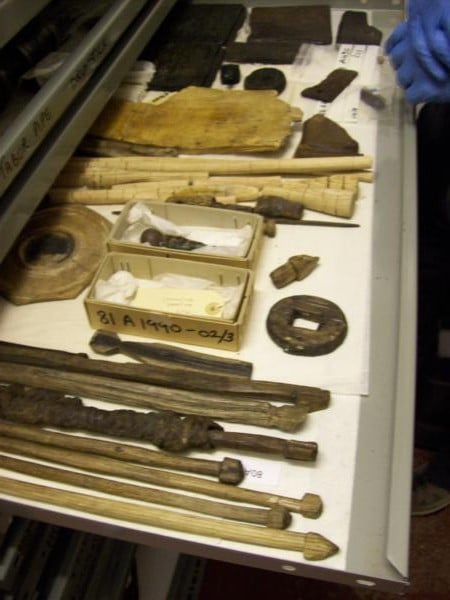
Before I share with you the latest Mary Rose Trust press release, I just want to thank you all for supporting The Anne Boleyn Files’ endeavour to raise £500 for the Mary Rose 500 Appeal. If you remember, we were the first of Henry VIII’s wives to pledge to raise £500 for the appeal and I’m happy to say that, at the time of writing this, we have raised £602 for the appeal.
I decided to support the appeal because I felt it was important that the Mary Rose ship, and the 19,000 artefacts that were recovered with it, should be on public display so that people could learn more about Tudor history. When she is put back on display in the new purpose built museum, the Mary Rose will be the only 16th century warship on display in the world, and that’s amazing when you think that she was originally launched in 1511.
If you want to help us support this appeal, you can:-
- Purchase our $2 Anne Boleyn Resource Guide (every cent goes to the appeal) at https://www.theanneboleynfiles.com/products-page/anne-boleyn-resource-guide/
- Purchase the Jane Seymour Pink Marble Necklace or All Pink Marble Necklace at https://www.theanneboleynfiles.com/products-page/six-wives-jewelry/jane-seymour-jewelry/
- Donate at our special Anne Boleyn Files Just Giving page
Here is the latest update from the Mary Rose Trust:-
Work Begins on Europe’s Biggest New Museum Project

Work began yesterday on the most ambitious heritage construction project seen in Europe this decade.
On the 28th anniversary of the raising of the Mary Rose, work to secure the future of King Henry VIII’s favourite ship has started as part of a £16.3 million contract to build the new Mary Rose Museum in Portsmouth Historic Dockyard.
Warings, a member of the international construction and services group Bouygues, is delivering the construction phase of the £35 million project for the Mary Rose Trust, the charity responsible for the conservation of the Tudor flagship which sank in action in 1545.
Construction of the museum began 28 years to the day after the raising of the Mary Rose from her muddy tomb on the bed of the Solent, in front of a worldwide television audience of 60 million.
The build is a major step in the final chapter in the conservation of the great ship, a painstaking process which began in 1982. The museum, scheduled for completion in autumn 2012, will reunite the Mary Rose with the majority of the 19,000 beautifully preserved artefacts recovered with her, to present visitors with an unparalleled experience of Tudor life.
Rear Admiral John Lippiett, Chief Executive of the Mary Rose Trust, said; “We are delighted to have appointed Portsmouth-based Warings for delivery of the construction phase of this historic project.
“The significance of the Mary Rose collection cannot be underestimated and we still have a £4 million fundraising target to meet before the museum can be opened to the public in 2012, the UK’s Olympic year.
“One year on since the launch of the Mary Rose Public Appeal we remain reliant on the public to continue to ensure this national treasure is preserved for future generations.”
The Mary Rose Trust still has to raise further funds to secure the future of Henry VIII’s flagship. The Trust is tasked with raising a total of £15 million to match fund the £21 million Heritage Lottery Fund grant, one of the largest made, which the new museum project has received. The Trust receives no central funding and is entirely reliant on donations to reach its ambitious final target.
Philippe Jouy, Warings Managing Director, added;
“This is a unique project which will pose some unique challenges for our dedicated team. Not least is the immense care required to build a modern museum around the precious timbers of the ship as the final stages of its conservation continues. We are well-equipped with the necessary skills and expertise and are proud to be leading this landmark development to protect and preserve a British historic icon.
“The museum will represent the very best in 21st century architecture and construction, providing a beautiful and secure environment for the finest collection of 16th century artefacts in the world.”
The new building housing the Mary Rose’s fully conserved hull and her artefacts will take the form of a finely crafted wooden ‘jewellery box’, clad in timber planks. It will replace the current temporary museum located 300 metres away, which has space to display only one twentieth of the Tudor items recovered with the wreck.
During the construction of the new museum the Mary Rose is out of view to the public. When the new museum opens in 2012 the preserving chemical sprays that keep her shrouded in mist will be gone. The ship will be on display during the final phase of conservation – controlled air drying – until 2016 when her 34 year conservation process will be complete.
The existing Mary Rose Museum remains open during construction to offer an amazing visitor experience with more than 1,000 of the finest conserved artefacts recovered from the site.
To help secure the future of The Mary Rose visit www.maryrose.org
